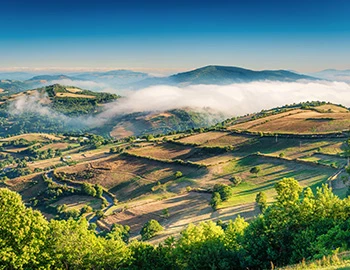Tessin
Ticino: the Merlot Mecca of Switzerland
Ticino winegrowing is thought to date from Roman times, as early as 2000 years ago. But the foundation for today’s viticulture was laid just over 100 years ago, in 1907. It was then that the first Merlot vines were planted at Castelrotto in Malcantone. Since then, the variety has emerged triumphant here. Top selections matured in barriques more than measure up to those from Bordeaux’s Saint-Émilion or Pomerol regions.
Sparkling wines from Tessin
White wines from Tessin
Rosé wines from Tessin
Red wines from Tessin
Delicatessen from Tessin
There are very few politicians who also achieve their goals in private projects. The Ticino State Councillor Giovanni Rossi (1861-1926) was one such politician. Having grown up in a wealthy middle-class family with vineyard property in Castelrotto, he studied medicine in Geneva, and, upon returning, he became known in Ticino as a liberal reformer. Even before he was elected to the City Council and took over the Cantonal Department of Agriculture in 1909, he reformed the starving wine industry after the phylloxera pandemic. In order to be able to produce better quality wines, he personally introduced Merlot seedlings into Ticino, planting them in his vineyards. Today, around 85 percent of the total cultivation area of 1,040 hectares is planted with Merlot.
Departure in the 1980s
For decades, however, only insignificant wines for serving by the glass were produced from this variety. It was only in the 1980s that a group of German-speaking Swiss dropouts came to Ticino to make wine – vinifying Merlot according to Bordeaux style, with long maceration and maturation in barriques – that the potential of this variety became apparent.
A lot of sun – but also a lot of rain
Ticino is regarded as Switzerland’s solarium, and indeed 2,200 sunshine hours is noticeably higher than that seen north of the Alps. But Ticino also gets record precipitation at 1,900 millimetres per year per square metre. Depending on the weather, quality differences can be discerned from year to year. The cultivation area is divided into two sub-regions. In the northern part is the Sopraceneri (Bellinzona, Blenio, Leventina, Locarno, Rivera, Maggia Valley), where the climate and the soils are influenced by the nearby Alps. Finely fruity, very elegant Merlots result from here. In the southern part, the Sottoceneri, it is warmer and the soils are more calcareous, with a high clay content. This yields concentrated wines.
White surprises
Although Merlot is the most prominent variety in Ticino, the long-established Bondola variety, along with international varieties like Cabernet Sauvignon, Petit Verdot and Cabernet Franc, yield high quality wines. A real insider’s tip: the white wines are also high quality. Above all, Chardonnays from Ticino rank among the best produced in Switzerland today..


















